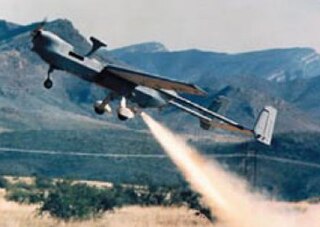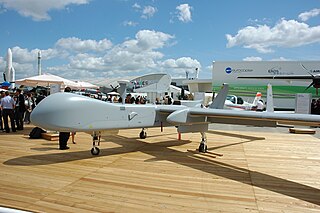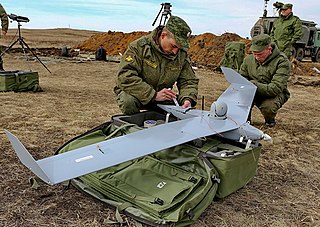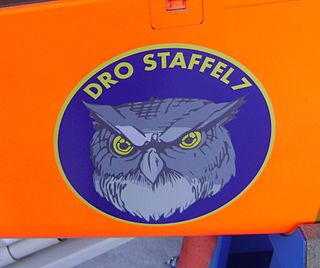
The IAI RQ-5 Hunter is an unmanned aerial vehicle (UAV) originally intended to serve as the United States Army's Short Range UAV system for division and corps commanders. It took off and landed on runways. It used a gimbaled EO/IR sensor to relay its video in real time via a second airborne Hunter over a C-band line-of-sight data link. The RQ-5 is based on the Hunter UAV that was developed by Israel Aerospace Industries.

Israel Aerospace Industries, is Israel's major aerospace and aviation manufacturer, producing aerial and astronautic systems for both military and civilian usage. It has 14,000 employees as of 2021. IAI is state-owned by the government of Israel.

The IAI Heron (Machatz-1) is a medium-altitude long-endurance unmanned aerial vehicle (UAV) developed by the Malat (UAV) division of Israel Aerospace Industries. It is capable of Medium Altitude Long Endurance (MALE) operations of up to 52 hours' duration at up to 10.5 km (35,000 ft). It has demonstrated 52 hours of continuous flight, but the effective operational maximal flight duration is less, according to payload and flight profile. An advanced version, the Heron TP, is also known as the IAI Eitan.

The Elbit Hermes 450 is an Israeli medium-sized multi-payload unmanned aerial vehicle (UAV) designed for tactical long endurance missions. It has an endurance of over 20 hours, with a primary mission of reconnaissance, surveillance and communications relay. Payload options include electro-optical/infrared sensors, communications and electronic intelligence, synthetic-aperture radar/ground-moving target indication, electronic warfare, and hyperspectral sensors.

The Elbit Systems Skylark I and Skylark II are miniature UAVs developed by Elbit Systems. Initial models of the Skylark entered service in 2008.

The IAI Scout is a reconnaissance unmanned air vehicle developed in Israel in the 1970s by Israel Aircraft Industries as a competitor to the Tadiran Mastiff. The project was led by Charley Attali, David Harari, and Michael Shefer who were all awarded the 1981 Israel Defense Prize.

The IAI Searcher is a reconnaissance UAV developed in Israel in the 1980s. In the following decade, it replaced the IMI Mastiff and IAI Scout UAVs then in service with the Israeli Army.

The IAI I-View is a small reconnaissance unmanned aerial vehicle developed in Israel in the early 21st century. Like other UAVs produced by IAI, it has fixed landing gear and an 18.6 kW (25 hp) piston engine. The Eye-View is also being promoted in civilian markets for forest fire warning, and in this form is appropriately known as the FireBird.

The IAI Eitan is an unmanned reconnaissance aircraft developed in Israel in the early 21st century by the Malat division of Israel Aerospace Industries. The aircraft is a newer version of the IAI Heron. Along with intelligence, surveillance, target acquisition, and reconnaissance (ISTR), Israeli IAI Eitan also capable of holding armed roles. There are conflicting reports on whether the exported Eitan's are unarmed or armed.

The IAI Harop is a Loitering Munition (LM) developed by the MBT Missiles Division of Israel Aerospace Industries. Loitering munitions are designed to hover or loiter above the battlefield, waiting for targets to be exposed, and attack upon the operator's command.

The EADS Harfang, formerly known as Système intérimaire de drone MALE is an unmanned aerial vehicle used by the French Air Force, supplementing the RQ-5 Hunter.

IAI Bird-Eye is a family of mini-UAVs developed by Israel Aerospace Industries (IAI) Malat division. Designed for military and paramilitary intelligence, surveillance and reconnaissance missions.

The Elbit Systems Hermes 900 Kochav ("Star") is an Israeli medium-size, multi-payload, medium-altitude long-endurance unmanned aerial vehicle (UAV) designed for tactical missions. It is a successor to the Hermes 450 series of drones, one of the most widely used military drones in the world.
IAI-HAL NRUAV is a unmanned rotorcraft project being co-developed by Malat Solutions, a unit of IAI of Israel, and HAL of India for the Indian Navy.
The IAI Ghost is a reconnaissance mini unmanned air vehicle developed in Israel by Israel Aircraft Industries. It is the second tandem-rotor UAV developed by IAI after IAI Panther.

The Drohnesstaffel 7 is a Militia squadron, stationed on the Militärflugplatz Emmen and is under the drone command 84. Drohnesstaffel 7 has as Coat of arms a round badge that shows the head of an owl against a dark blue background and the yellow inscription "Dro Staffel 7". It is the only UAV squadron of the Swiss Air Force. The owl symbolizes the good sight of the UAV sensors by day and night.

The Albatross(Chinese: 銳鳶; pinyin: Ruì yuān,“Sharp Kite”), also known as the Chung Xiang II, is a medium unmanned aerial vehicle made by National Chung-Shan Institute of Science and Technology. It is in service with the Republic of China Navy.

An unmanned surveillance and reconnaissance aerial vehicle, is an unarmed military UAV that is used for intelligence, surveillance, target acquisition, and reconnaissance (ISTAR). Unlike unmanned combat aerial vehicle (UCAV), this type of system is not designed to carry aircraft ordnance such as missiles, ATGMs, or bombs for drone strikes. The main purpose is to provide battlefield intelligence. Small sized short-range man-portable unmanned aerial vehicles are called miniature UAV also used for battlefield intelligence.
UAVs in the Armée française are unmanned aerial vehicles with reconnaissance equipment or weapons on board. The French armed forces use drones for reconnaissance and combat purposes. They are under the command of the French Air & Space Force.

















